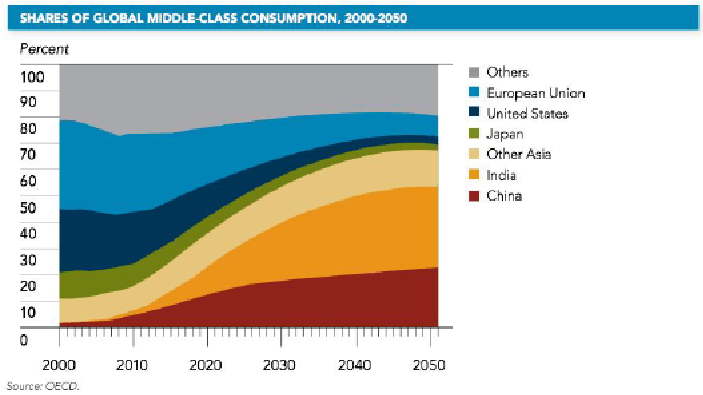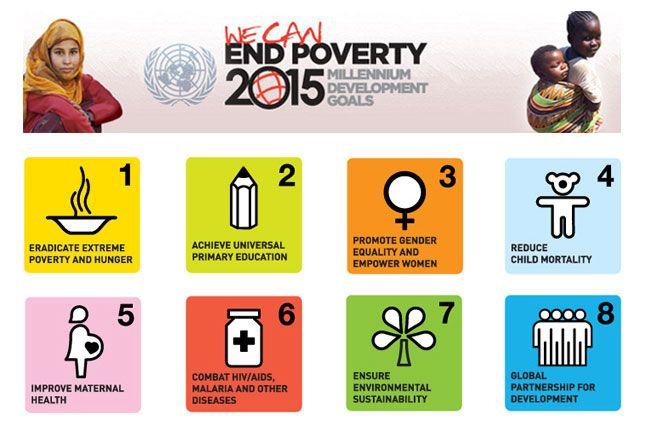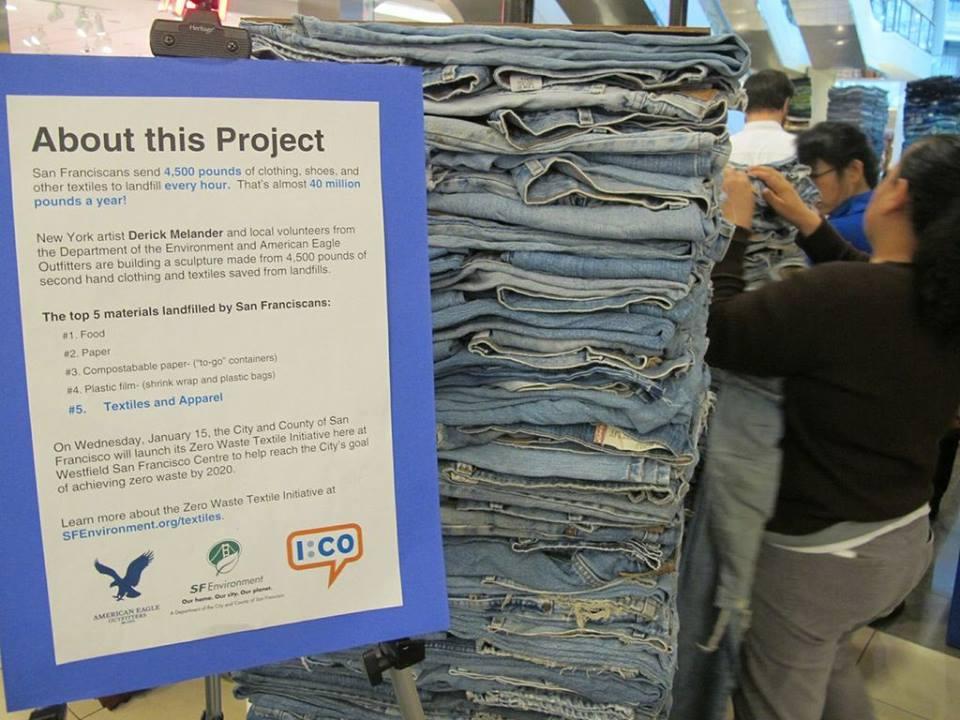3p Interview from #SB14sd: PwC on Resilience and Total Impact Measurement


Resilience in the face of climate change and resource constraints was a trending topic at the 2014 Sustainable Brands conference in San Diego. In one of many discussions on the issue, PwC and author, speaker and environmental strategy consultant Andrew Winston led a panel on "building good growth" in a brand.
Part of the conversation centered around using breakthrough techniques like natural capital management and total impact measurement to build resilience and strengthen brand value. I sat down with panelists Clinton Moloney and Amy Longsworth of PwC after the discussion to find out more.
TriplePundit: Your chat focused on creating measurable sustainable value for brands. For folks who weren't able to attend, can you speak to how you define "measurable" and "sustainable" value?
Clinton Moloney: You have to look at what measures or what value you are talking about and to whom. We spend a lot of time with investors and shareholders, and they're looking for two things: They're looking for how to improve financial performance in the next quarter, as you might imagine. But we just completed a study where we found that one-third of investors with more than $100 billion under management say they need more on sustainability to be able to make high-quality, long-term investment decisions.
If you look at what companies are reporting today, they're doing many many things, and the question is: How do you narrow that reporting in on things that are more material? So, we spend time helping companies make that link between sustainability performance and business performance, and we're hearing pretty loud and clear from investors that there's a real need for that. Fund managers can't play casino capital like the short-term traders do on Wall Street. They're looking to place assets over the longer term, and they're the investors for whom sustainability really matters.
3p: Wow, one-third. That's pretty impressive.
CM: We think it's really telling. Sustainability has gone mainstream. This is not a niche thing; it doesn't matter to some companies. If you've got a third of your most important shareholders telling you that they're trying to get more information on how you're performing, we think companies should respond.
We have the great privilege of spending a lot of time with boards and executives, and what it comes down to in many cases is that you manage what you measure. We think it's part of our mission to help create and promote ways of measuring performance so that companies can do a much better job of making high-quality decisions when it comes to how they want to invest in making the world more sustainable.
Amy Longsworth: Because of the climate change events that have been happening, there's also more of an awareness of risk. It's more accepted and known that companies are vulnerable. And so it's important to ask: What are those indirect values or risks that are not being accounted for by traditional financial books?
You asked about what impact measurement and management really is. Rather than just looking at traditional returns, this approach will ask: What are the social impacts? What are the environmental impacts? What are the economic impacts — the broader economic impacts, not just the return to the company?
Impact measurement takes these things that are not traditionally measured in dollar terms and allows them to be measured in dollar terms. Most of these are risks and opportunities that everybody intuitively knows exist and the investors increasingly know they exist, but they haven't been incorporated into the traditional financial view of how companies are valued.
3p: With that in mind, can you speak to the difference between many of the sustainability targets we see from companies today — such as cutting water use by 10 percent or reducing GHGs by 15 percent, which are often arbitrary — and goal-setting that's based on your total impact and scientific targets?
AL: The goal-setting is a little bit of a different topic, but it definitely relates to this. I think Andrew [Winston] has the best analogy of a sinking boat: Instead of asking how much everybody can bail today, it makes more sense to ask, "How much do we have to bail to not allow the boat to sink?"
How does that relate to total impact measurement and management? For whatever goals you set, you're then going to have results coming out that look at the effect of your actions. It may give you a positive return and it may give you a negative return. It's essentially a gigantic balance sheet.
CM: We put out a study recently that we do fairly routinely [the firm's annual Low Carbon Economy Index], looking at how much progress business in general is making toward keeping us below 2 degrees Celsius from a climate change point of view. Our estimate is that we need a 6 percent year-by-year improvement in carbon efficiency across the economy, and we've been able to show which countries are doing that or which sectors are doing that. The reality is that no one is yet living up to the target we need to hit of this 6 percent year-on-year improvement.
For some of our clients, we're seeing them start to realize that if they really want to make their fair-share contribution toward mitigating climate change, they need to set science-based goals.
3p: Do you feel companies are ready for the dramatic shift necessary to reach that 6 percent goal?
AL: There's going to be an interesting pivot … between how far companies can go using traditional business models before they have to go into a completely different kind of economic approach. You really have to rethink your business model, which is very scary.
CM: As we're at a transition point in this discussion about climate change in this country, we've seen a range of inspiring leaders make change because they believe it's the right thing to do. Now that those folks have moved, we have to figure out how to convince the other 95 percent of CEOs that this is the smart thing to do for their business, that it's in their self interest, and that it's in their shareholders' interest. That's why we've invested in these techniques to help bring numbers to their argument, but we believe that when people look at the facts in the light of day, they're going to decide that they need to take a new and different approach because it's in their best interests to do so.
3p: PwC recently completed the 17th annual Global CEO Survey. How do CEOs feel about this?
CM: Forty-six percent of the [1,600 global CEOs] we interviewed put climate change and resource scarcity in the top five issues that they're concerned about. That's a significant move from what we've seen previously, which indicates business people are recognizing these issues as business issues.
From our research, we're telling our clients that by 2030 we're going to need 35 percent more water, 40 percent more food and 50 percent more energy. When you have those mega trends occurring on a global level — and with climate change being a global issue — it creates a range of opportunities for companies. You can't just look at high-level trends; you have to dig deeper and see what the secondary effects are.
We're excited to see a much more sophisticated business conversation happening now than we have in the past. Investors asked for more high-quality data — not the ones who are trading in milliseconds, the ones that plan on holding stocks for a long time. Those investors are really voting with their money. They're putting dollars into companies that are performing in a superior way on sustainability, and they're asking for better data to make those comparisons more real.
3p: How do companies get people excited and engaged about their sustainability goals?
AL: There's a really interesting question, bringing it back to this conference, of how you communicate — putting everything that we just talked about on a hang tag, or making it in some way known and meaningful to people. That just gets into business model changes that may be driven by some of the forces that we've been talking about, which is a whole other area for innovation and exploration for people and what it is that they can know, absorb and decide about. As human beings, we're notoriously bad at gathering information ahead of time and making rational changes, or else I don't think we'd be where we are today.
CM: There's a "knowing and doing" gap. People can know stuff, but there's a big gap between what they know and what they're doing. I think it's our job to help close that gap.
3p: In May, PwC released a study on value and sustainable supply chains with APICS. Can you tell me a bit about that and how it fits into this larger conversation around total impact management and brand value?
CM: I think it comes down to reputation. If you look at the valuation of companies nowadays, 80 percent of their value is in their brand and in the intangibles, relative to the book value of their assets. This means reputation is a critical thing, and that value can be destroyed quickly. I think companies have begun to embraced this idea of extended responsibility — outside their four walls — and they want to make sure they're doing business with others that have value, reputation and are credible.
AL: There are also other aspects to sustainability in a supply chain. One is the risk in an extended supply chain that's now shipping parts around the world, and we've seen terrible disruptions — such as floods affecting the automotive and aerospace industries and other examples.
Then there's also your customer asking you, and there's this proliferation of questionnaires: Do you have supply chain standards? What are they? Do you enforce them? So you have to be able to answer those questions truthfully but also hopefully with a "yes." Solid sustainability performance is not a reason to do business with a company necessarily, but it becomes a reason not to do business with a company if you can't answer yes.
Stay tuned for more coverage from #SB14sd here on Triple Pundit!
Logo courtesy of PwC
Based in Philadelphia, Mary Mazzoni is a senior editor at TriplePundit. She is also a freelance journalist who frequently writes about sustainability, corporate social responsibility and clean tech. Her work has appeared in the Philadelphia Daily News, the Huffington Post, Sustainable Brands, Earth911 and the Daily Meal. You can follow her on Twitter @mary_mazzoni.
C2C Reveals the Benefits of 'Remaking the Way We Make Things'


Throughout the course of history waste, environmental degradation and pollution have grown alongside human population and economic activity. Economies and people's livelihoods have become dependent on producing and consuming myriad products made up of chemical compounds unknown in nature or to them -- and indigestible to the Earth's natural processes of recycling and reuse.
To produce these products, we destroy ecosystems and wildlife – even other people at times – and pollute the air, water and land. When we're finished with them, we discard them to be carted off, dumped, buried or incinerated. A small, but significant and growing amount, we recycle or reuse.
Some might say, "That's nature, and we're just a part of it." Others are using the gifts nature has endowed us with to find better ways of designing and making things -- ways that are not only socially, ecologically and economically sustainable, but can actually leave a net positive footprint on societies and our planet.
In the 2002 book, “Cradle to Cradle: Remaking the Way We Make Things,” architect William McDonough and chemist Dr. Michael Braungart introduced the concept of cradle-to-cradle product design.
Taking up and expanding on the concept and its principles, the Cradle to Cradle Products Innovation Institute today released a study exploring the business, environmental and social impacts on 10 pioneering companies participating in a pilot implementation of its Cradle to Cradle Certified Products Program.
Cradle to Cradle Explained
After 18 years of working with leading brands to develop it, William McDonough and Dr. Braungart handed the Cradle to Cradle Certified Product Standard over to the nonprofit Cradle to Cradle Products Innovation Institute (C2CPII).
As the institute explains, it was “created to bring about a new industrial revolution that turns the making of things into a positive force for society, economy, and the planet.”
Quite a mandate. So just how exactly does the institute follow through and seek to realize its goals? The short answer, as C2CPII President Bridgett Luther writes in the foreword to the pilot study technical report, is “by working to innovate well-designed, healthy products with reusable and safe materials, made without the need to deplete precious resources or energy.”
Elaborating a bit on this statement, the institute explains that the Cradle to Cradle Certified Products Program guides continual improvement towards products that are:
- made with materials that are safe for humans and the environment;
- designed so all ingredients can be reused safely by nature or industry;
- assembled and manufactured with renewable, non polluting energy;
- made in ways that protect and enrich water supplies; and
- made in ways that advance social and environmental justice.
The Cradle to Cradle Product Certification Pilot Program
Exhibiting an admirable sense of “responsible leadership,” some of the world's leading businesses have signed on to the Cradle to Cradle Product Certification Pilot Program and are helping realize C2CPII's goals. All told, C2CPII has evaluated products from more than 200 companies for certification.
To reach out and spread the Cradle to Cradle message more broadly, in its pilot program technical report C2CPII profiles 10 pilot program companies that differ in size, location and product offerings. In doing so, the institute explores “the economic, social, and ecological benefits of certification.”
As highlights, C2CPII in a press release offers three examples from participating companies:
- AGC Glass Europe Panibel Dark Blue - Certification and optimization of its product and processes illustrated a clean energy strategy that led to over 40 percent of fuel oil replaced by 'cleaner' natural gas; its cost to human well-being was reduced by 60 percent; and its sales are over 21 percent higher than the rest of the industry, due in part to winning new business from clients in the green building market.
- Construction Specialties Acrovyn 4000 product eliminated 100 percent of its PVC in the product after certification; realized 50 percent of its energy use is renewable and the remaining 50 percent is offset by renewable energy credits; and its cost to human well-being was reduced by 57 percent.
- Shaw EcoWorx carpet tile received a 46 percent increase in recycled content; a 50 percent increase in water efficiency; a 48 percent increase in sales; and its costs to human well-being was reduced by 50 percent due to energy efficiency improvements and switch to renewables.
C2CPII's technical report also details the experiences of the seven other Cradle to Cradle Product Certification Pilot Program participants – Aveda, Desso, Ecover, Mosa, Puma, Steelcase and Van Houtum. Among the business benefits realized from participating in the certification program, the report authors highlight, were “reduced costs, improved product value, new revenue streams and avoided risks.”
In addition, they continue, pilot certification program participants' experiences with adopting the Cradle to Cradle Certified Product Certification framework “illustrates the structural cost reduction through re-using product material and increasing resource efficiency. By avoiding traditional resource markets and by reducing dependency on non-renewable energy, the report shows companies’ risk was reduced from volatile commodity prices and supply disruption.”
With a “middle class” of consumers emerging in populous, rapidly developing nations such as Brazil, China and India, humanity has come to a pivotal and critical point in time with an increasingly pressing need to rethink and find ways of designing products in economically viable ways that don't degrade people or the environment, Luther highlights in the foreword of the report.
“Billions of people around the world are poised to gain middle class consumer power to change how we design, use and reuse products," Luther said. "If the world is going to flourish, shared prosperity must be realized with a new consumption model free from waste, pollution, and social and environmental expense. The model is Cradle to Cradle and its implementation is the certification program.”
Image credits: Cradle to Cradle Products Innovation Institute
A Triple Play on Climate Change: China, India, U.S. Take Action


This past Monday, EPA Administrator Gina McCarthy unveiled the Obama administration's highly anticipated proposal to reduce carbon dioxide (CO2) emissions from existing U.S. power plants, the president's strongest action yet to halt the rise in carbon and greenhouse gas (GHG) emissions that are prompting a shift in global climate. A day later, Reuters reported that a senior government adviser said that China will impose a cap on CO2 emissions in 2016.
Alone, one of these developments would add substantial impetus to global climate change mitigation efforts and prospects of achieving a global climate change accord. Taken together, it doubles them, at the least.
How about tripling them, or more? Two weeks ago, India's new Prime Minister Narendra Modi announced his intention to see that every Indian home gets at least some electricity from clean, renewable solar power by 2019.
Yes, India's new PM, President Obama and China Premier Li Keqiang and supporters have many hurdles to overcome and battles to fight for these initiatives to be realized. But to witness all three prominent national leaders take strong, definitive steps to mitigate climate change, well, it's a historic milestone, to say the least.
Unilateral actions boost prospects for a global climate accord
The announcement of new, more ambitious carbon emissions reduction programs by China and the U.S. – the world's largest and second largest emitters, respectively – should motivate other developing and developed nations to follow suit and strike a deal to limit and reduce emissions globally over the course of this and coming decades.
Taken individually, the coincidence of strong unilateral climate change mitigation/clean energy policy announcements by the leaders of the world's first, second and fourth largest CO2 emitters is the biggest breakthrough yet in the decades-long effort to reduce climate-warming greenhouse gas emissions. Taken together, they could provide the impetus for negotiators to strike a deal to limit carbon and greenhouse gas emissions globally.
Aiming to make progress regarding the Durban Platform for Enhanced Action – an initiative to spur a global climate change accord intended to pick up where the Kyoto Protocol left off – the United Nations Framework Convention on Climate Change's (UNFCCC) Subsidiary Body of Implementation (SBI) and Subsidiary Body for Scientific and Technological Advice (SBSTA) will meet for the 40th time at the Bonn Climate Change Conference in Germany June 4 through June 15.
Representatives from all 195 U.N. member nations and the EU party to the UNFCCC are to meet and try and seal a deal at the 21st UNFCCC Conference of Parties (COP) in Paris in December 2015.
Addedd momentum for U.N. Sustainable Development Goals
In turn, these unilateral climate change mitigation actions also help clarify and add momentum to efforts to find cleaner, healthier, more inclusive and equitable sustainable development pathways.
In addition to the UNFCCC's COP 21 meeting in Paris, 2015 is the final year of the U.N. Millennium Development Goals (MDGs), which have defined the U.N.'s strategic mission since the Millennium Declaration was ratified by the U.N. General Assembly in September 2000.
In parallel with efforts by the UNFCCC to pave the way for a global climate treaty to be signed in Paris, U.N. Secretary General Ban Ki-moon has been leading an organization-wide initiative to hammer out the details of a successor to the MDGs.
Initially presented for consideration during the 68th session of the U.N. General Assembly at the U.N.'s New York City headquarters in late September 2013, the U.N. Sustainable Development Goals (SDGs) will define its development agenda post-2015.
Image credits: 1) Interesting Energy Facts at blogspot.com 2) U.S. EPA 3) U.N.
Procter & Gamble Doubles Down on Sustainability


There are some big changes afoot at consumer products giant Procter & Gamble (P&G), though with little in the way of comments from the company, it’s anybody’s guess what’s behind it.
Here are the facts. The company announced that it is consolidating facilities, and cutting some 3,000 office jobs over the next two years. A company spokesman said that the move to close one office in Geneva, “was enabled by leveraging more flexible office designs, increased use of digital technology and improving our environmental sustainability.”
Sustainability is a big topic at the company, especially after the Dow Jones Sustainability Index dropped P&G from its Top 100 list of most sustainable companies in North America. This must have come as quite a blow after the company had been on the list for 14 consecutive years and named as the leader of Nondurable Household Products sector for seven years straight. The company now considers environmental impact a top priority, “as important as a new product launch or a business acquisition.”
The company was named as a hero in last year’s Canadian Corporate Knights report. Among the accomplishments cited by the report was the fact that 25 percent of its 192 plants were certified zero waste. The company is committed to finding the value throughout its supply chain that might have once been considered waste. “Only in a landfill does that waste have no value,” said Len Sauers, vice president for global sustainability. “Our goal was to find some value in all that waste, which has been a good investment for the company. Plus, not paying to have the stuff landfilled.” Some examples include paper sludge being converted into roofing tiles and waste from a feminine care pad plant converted into fuel for a local cement plant. All told, the company has saved $1 billion in landfill costs since 2007.
Obviously there is not only subjectivity in the various ranking systems, but each one uses different criteria with different emphasis.
The company, which is renowned for its cleaning products, has just brought back CEO A.G. Lafley to help them clean up their act. Lafley was at the helm during a very dynamic period of growth for the company in the early 2000s, but that was before sustainability was the hot topic that it is today.
P&G was called out for being the second highest producer of greenhouse gases among consumer products companies, and for not reducing emissions as much as its rival, Kimberly-Clark.
This, according to BrandChannel, might create a quandary for a company of this size -- which is a perceptual gap between what environmentalists and journalists care about, as opposed to what the typical consumer that buys their products care about. That’s because in today’s hyper-connected world, where generational buying decisions and brand loyalties can be overturned by a single tweet, reputation means everything. At the same time, 75 percent of consumers say that they will not accept any tradeoffs for products that are more sustainable than their traditional counterparts.
A few actions the company has recently taken include a pledge to cut water content in laundry detergent by 25 percent by 2018, saving 45 million gallons of water annually; and joining with Walmart in the $100 million Closed Loop Fund to help encourage recycling programs. The company has also responded to Greenpeace protests by vowing to begin policing its entire palm oil supply by next year. Social media played a big role on this issue in bringing P&G to the table.
So what can we take away from this story?
We can say that sustainability matters a lot to consumers, even those who don’t traditionally have green values. That's because, all other things being equal, consumers want to feel good about the products they buy and the companies they buy from. But the “all other things being equal” part, might be the most important part of all.
RP Siegel, PE, is an author, inventor and consultant. He has written for numerous publications ranging from Huffington Post to Mechanical Engineering. He and Roger Saillant co-wrote the eco-thriller Vapor Trails. RP sees it as his mission to help articulate and clarify the problems and challenges confronting our planet at this time, as well as the steadily emerging list of proposed solutions. His uniquely combined engineering and humanities background help to bring both global perspective and analytical detail to bear on the questions at hand.
Follow RP Siegel on Twitter.
ISO 14001 Certification Shown to Provide Competitive Edge, Report Finds


By Robert Fenn
Certification to the ISO 14001 environmental management standard has been shown to help organizations win business, according to the evidence shown in the British Assessment Bureau’s 2013 Client Satisfaction Survey.
The British Assessment Bureau, a U.K.-based certification body, commissioned their survey early in 2014, which was carried out independently by Lake Market Research. Respondents with ISO 14001 certification were asked for their motivations behind implementing the standard, followed by what they had achieved having successfully gained certification.
A large proportion of respondents said the standard’s ability to help them win new business was a major motivation in deciding to implement the standard, with 50 percent saying it was to help them with tenders or obtain new business. In addition to this, 39 percent of respondents said that the standard would help them meet customer or industry requirements, and a further 12 percent chose ISO 14001 as a way of raising their profile.
ISO 14001 certification demonstrates that an organization had its environmental credentials verified by an independent third party, and provides a framework for people to reduce energy consumption and waste, while improving recycling and legal compliance. As a result, ISO 14001 is often stipulated by procurement departments as a way of ensuring suppliers meet a recognized environmental standard.
When asked how ISO 14001 certification had benefited their organizations, mirroring their motivations, 43 percent of respondents said that it had helped them win new business or made them more successful in tenders. This was a 19 percent increase in change from the British Assessment Bureau’s 2012 survey, indicating that ISO 14001 is becoming more important in the eyes of buying authorities.
Further to these results, 18 percent said that ISO 14001 certification allowed them to tender for new work and 16 percent said certification had raised their profile, showing further promise that the standard could be the key to realising new business opportunities.
This news follows a series of reports from the Intergovernmental Panel on Climate Change (IPCC) showing that humans are unequivocally to blame for climate change. The reports, approved by 194 governments around the world, resulted in a number of new targets being set. Over the coming years, this will impact all organizations as they are asked to do their bit for the environment as pressure from supply chains grows.
Already, the International Organization for Standardization – the body responsible for ISO standards – has indicated that ISO 14001 is growing on a worldwide level, with 6 percent growth shown in their latest survey. With ISO 14001 set to be revised and updated in 2015, the standard is set to be become the proven way for organizations to demonstrate that they take environmental management seriously.
Do you think the ISO 14001 environmental standard has gained momentum? Join the conversation in the comments below, or via Twitter @TriplePundit
Image credit: iStockPhoto
Robert Fenn is a Director at the British Assessment Bureau, a UK based Certification Body. Robert is an experienced speaker and writer on sustainability and corporate responsibility within the business world.
Interview: Brett Hauser, President of Greenlots and Founder of Open Charge Alliance


TriplePundit reported live from the Fortune Brainstorm Green 2014 conference in Laguna Niguel, CA. Follow along on this page for ongoing video interviews with sustainability thought leaders, corporate change agents and entrepreneurs who are leading the way to a more sustainable future.
Despite many options and generous subsidies, only 52,835 of the 14.5 million cars sold in the U.S. in 2012 were EVs or plug-in hybrids. The good news is that the numbers are quickly growing. I sat down with Brett Hauser, President of Greenlots and Founder of Open Charge Alliance to answer the question "what will it take to put 1 million EVs on the road by 2017?"
Greenpeace Reviews Major Food Retailers for Sustainable Seafood Purchasing


While the dedicated startups that spearhead the sustainable seafood movement through things like community supported fisheries (CSFs) and green aquaculture are exciting, these fish will take a while to hit your local grocery store.
That is why today’s story about the work Greenpeace has been doing in rating the sustainability practices of major food retailers might have the greatest impact of all, at least in the near term.
Greenpeace just issued the eighth edition of its report entitled Carting Away the Oceans. The wide-ranging report covers everything from human-rights abuses in the industry, to GMO salmon, to protecting America’s fish basket in the Bering Sea, where roughly one-half of all seafood landed in the U.S. comes from.
But the main focus of the report is the ratings, which evaluate 26 major American grocery store chains -- including everyone from Whole Foods and Trader Joe's to Kroger, Safeway, Target and Walmart.
I spoke with report author James Mitchell, senior oceans campaigner with the Greenpeace Oceans program, about the significance of the report.
Triple Pundit: So what have you learned from doing these supermarket ratings?
James Mitchell: It's phenomenal how these grocery stores have been changing over time, in response to consumer demand. When we first ran this assessment back in 2008, literally all of the stores failed. Now in our 2014 edition, the vast majority of retailers, 22 out of 26, passed. And four of them -- Whole Foods, Safeway, Wegmans, and Trader Joe’s -- actually landed a “Good” score.
3p: Can you put these results into some kind of context for me? How are the oceans and fisheries doing?
JM: In the grand scheme of things, looking at the oceans as a whole, we’re in trouble. But in this specific area, the power of consumers is really becoming stronger every year. Not all retailers are that responsive, but on the whole, we’re seeing progress at a level that is really impacting the industry.
3p: Can you give me an example?
JM: Take a look at the canned tuna -- the most heavily consumed wild-caught seafood. We eat more canned tuna here in the U.S. than any other country. Canned tuna is probably the most affordable seafood out there. We’ve been having a lot of conversations with retailers about this. asking them to release a sustainable private label (store brand) tuna. We’ve seen some great turnaround in that area in the past couple of years. This is important because now sustainably caught tuna does not cost much more than some of the big tuna companies that unfortunately have not changed their ways yet.
3p: And grocery stores have done it?
JM: Yes. Now you can walk into a Whole Foods, a Safeway, a Trader Joe’s, a Walmart, or a Hy-Vee if you’re out in the Midwest, and you can walk out the door with sustainable private label tuna for a couple of dimes more than the cheap stuff. That’s a really impressive change in the industry over just a few short years, and it’s in an area that’s important to all shopping demographics.
3p: So what makes one can of tuna more sustainably produced than another?
JM: Most tuna out there, talking about chunk light, which makes up about 75 percent of the market, has primarily been caught with a conventional fishing method known as FAD fishing, where FAD stands for fish aggregation device. The FAD is nothing more than a manmade lure, which could be something very simple. Tuna fishermen deploy these FADs with a radio beacon attached so they can find them again. Unfortunately, what happens is you get an entire community of sea life aggregating around these FADs.
The fishermen then use a purse seine net that scoops up everything around it, and you’re left with a substantial amount of bycatch. This is done on such a massive scale worldwide, especially in the western and central Pacific Ocean, that the impact on the oceans is enormous. So what we’ve been saying is this: “There are two ways that you can make this better. One is to simply skip the use of the FAD itself and do what is called 'free school fishing,' where you find a school and pursue it, which results in a cleaner catch. Or, you could go back to pole and line, which is the gold standard for sustainable tuna fishing.” If you are hooking tuna, one at a time, this cuts the bycatch down to nearly zero, unlike the purse seine method, where, by the time you pull all those fish out of the water, most of them quickly die.
Another method used with albacore is 'long-lining,' which is where the boat pulls a long line with multiple baited hooks. This has about 30 percent bycatch, where birds, sharks and turtles often get caught or tangled up. We’ve talked with retailers about putting in some mitigative measures to make long-lining less destructive. This involves things like using circle hooks that keep the catch alive, so that incorrect fish can be released. Better yet, you can use pole and line. There are actually some companies doing that right now -- even some American companies, off the coast of California.
3p: But that’s bound to cost quite a bit more though, right?
JM: You’d think so. But you can buy pole and line caught skipjack tuna at Trader Joe’s for $1.49 a can. That’s top-of-the-line sustainability for $1.49. As these retailers become more vertically integrated and cut out the middle man, they can bring prices down. They also can employ economies of scale.
3p: That’s great. So let me ask you. I’ve spoken with a couple of people in the CSF world and they describe the very sustainable method they use, like pound trap nets as well as pole and line and even spear-fishing. They also said that fishing in the U.S. is quite sustainable because of the way fisheries are regulated under the National Marine Fisheries Service.
But you mentioned a couple of methods that are really not very sustainable. Are these legal under U.S. regulations? This is confusing. Can you shed some light on this?
JM: You’ve touched upon a really interesting issue. Our government’s laws only apply to fishing done within 200 miles of our shores. The vast majority of the tuna we have been talking about is coming from the other side of the planet. So we are commonly sourcing our seafood from very poorly regulated, and sometimes totally unregulated areas, while our own seas are highly regulated. What most Americans don’t realize that somewhere around 80 percent of all the seafood in the grocery store (Sean Barrett said the number was 90 percent) is imported. So we often end up eating fish that has been harvested in a manner that is less than ideal, if not downright terrible.
So both of those statements you made are actually correct. As a country, we manage our fisheries better than most. But we also end up exporting approximately 70 percent of all we catch here, while we import somewhere around 80 percent.
3p: And the reason why we do that is…?
JM: The reason why is because the Europeans and the Japanese recognize the appeal and the value of American-caught seafood and are willing to pay a premium price for it.
3p: That is so ironic, it’s bizarre.
JM: It is. It is. For some species, like farmed shrimp, for example, something like 97 percent of it is imported. So all the great standards that we have for seafood are not ending up on our dinner tables.
3p: Amazing. So let’s go back to your report. Tell me about the criteria you used.
JM: We basically look at four criteria in evaluating a supermarket’s performance. The first criteria is policy. We look to see if a retailer has a sustainable seafood policy in place governing purchasing decisions. If they do, then we look at how rigorous their standards are.
The second thing we look at are initiatives. Do they participate in coalitions with other external groups to really push for seafood sustainability. Do they communicate directly to fishery management authorities and policy-makers?
3p: Could you give me an example?
JM: One of the things we are involved in is protecting the Bering Sea canyons. Our rating system rewards retailers for getting involved in issues like this.
The third criteria is labeling and transparency. Consumers need information to make informed choices, so it’s important to know where the seafood comes from. Seafood fraud has been a big issue, so we really dig into this to be sure that the seafood truly comes from where they say it does.
Finally, there is the Red list inventory section. We have 23 marine species that we feel should not be made commercially available for a variety of reasons. One reason is overfishing, which is to say that they are being caught at a rate that is faster than they can reproduce. Then there is destructive fishing in terms of bycatch, as we talked about earlier. Even if species X is plentiful, but you are fishing for species X in a way that obliterates species Y and Z, that’s not okay. Likewise, if you fish for species X in a way that obliterates habitat, that’s not considered sustainable fishing either.
3p: This is great, though it doesn’t cover other facets of fish consumption like mercury levels, am I right?
JM: That’s true. We don’t get into that, only because that’s not our expertise. However, if you look at tuna, it turns out that sustainably caught skipjack tuna will have lower mercury levels because it doesn’t have bigeye and yellowfin mixed in with it.
3p: Anything else you’d like to add?
JM: Just that it’s always a good idea to ask: Where did this seafood come from?
3p: Often employees say they don’t know.
JM: That’s true. But some stores, like Hy-Vee, have employee training programs in place to be able to answer these kinds of questions.
3p: What about salmon, what kinds of concerns do you have about that?
JM: Best is wild-caught Alaskan. Anything that is farmed is Atlantic, even if it’s being raised on the West Coast. These should be avoided in general (though stay tuned for an exception next week). The fishery for wild Atlantic salmon has collapsed. We consider Atlantic salmon farms as being comparable to CAFOs [concentrated animal feeding operations] of the ocean.
3p: Where can one find more information about other red list species?
JM: You can find it here.
3p: Thank you very much!
Image credit: Louis Hansel/Unsplash
San Francisco Program Provides a Roadmap for Eliminating Textile Waste


More than 25 billion pounds of textiles are discarded in the U.S. annually, according to the U.S. Environmental Protection Agency, which equates to about 70 pounds per person, per year. Only about 15 percent of these textiles are collected for reuse or recycling, meaning a staggering 21 billion pounds of clothing and footwear remain destined for the landfill.
Those numbers are pretty grim, especially when you consider what it takes to produce the average shoe or garment: Manufacturing one T-shirt can consume up to 7,900 gallons of water and create 3.6 kilograms of carbon emissions. At the same time, 95 percent--some even say 100 percent--of the materials that make up our favorite fashions are reusable or recyclable, Jennifer Gilbert, chief marketing officer for I:CO, told Triple Pundit, and the water and carbon footprint of manufacturing can be slashed by up to 95 percent by using recycled feedstocks.
I:CO, which stands for "I collect," is a global, end‐to‐end solutions provider for apparel, footwear and other textiles reuse and recycling. Through its simple take‐back system and worldwide infrastructure, I:CO aims to keep used clothing and shoes in a continuous closed loop product cycle. The company began in Europe five years ago and came across the pond to the U.S. back in 2011. By partnering with top retail brands from around the world, including Levi Strauss & Co., H&M, Puma and the North Face, I:CO gives consumers the resources to recycle used textiles, as well as the education they need to make a behavior change.
The senselessness of tossing valuable materials into the landfill while expending staggering resources to create similar products from virgin feedstocks is more than enough justification for such a program. But Gilbert says an increase in textile recycling is as beneficial for people and profit as it is for the planet--reducing tipping fees, creating jobs and establishing closed loop manufacturing systems in cities around the world.
"It's all about economic growth: creating jobs, increasing awareness and having this become a way of life," she told Triple Pundit. "Our goal is to truly eliminate waste."
To take things a step further, I:CO launched its first ever I:CO City initiative with the city of San Francisco earlier this year. The launch creates a public, private and nonprofit infrastructure to make it convenient and rewarding for residents and businesses to recycle textile related items. In alignment with San Francisco’s goal of zero waste by 2020, I:CO will serve as the lead textile collection and processing partner to divert waste from landfill and give it new life.
I:CO, San Francisco and the Zero Waste Textile Initiative
Dubbed the Zero Waste Textile Initiative by the city of San Francisco, the I:CO City initiative makes it seamless and simple to recycle unwanted textiles. When I:CO approached the city looking to create something of a beta test for its infrastructure-based closed loop system, it seemed like a perfect match.
On its quest to achieve zero waste by 2020, San Francisco identified textiles as a major challenge: Before the I:CO partnership, textile waste comprised 3.4 percent of the city's total waste stream--making it one of the top 10 landfilled materials. Although the city boasts the highest recycling rate in the country at 80 percent, it still sends more than 4,500 pounds of textiles to the landfill every hour, Gilbert said.
To solve the problem, I:CO and its retail partners set up more than 100 collection bins at retail stores, apartment complexes, schools and public buildings around the city, and began awareness campaigns to encourage residents to recycle their clothes and footwear. After the items are picked up by I:CO, the company works with third party sorters and graders to break them into 400 different categories to allocate as second‐hand clothing, reuse as cloths, recycled into fibers and paddings, or upcycled into a product of equal or higher quality.
"We want to sort until there's nothing left to sort," Gilbert told us with a laugh.
Collecting with end use in mind
I:CO partners with brands to collect used clothing and shoes at retail outlets and reward the customer for their efforts, effectively extending product responsibility for manufacturers and allowing them to embrace sustainability as part of their goals. Each retail partner is also given the chance to select a charity recipient for all proceeds that come from collected clothes. But, as Gilbert pointed out, collection is only the beginning: "It's not only about dropping clothes in a box, and our partners know that," she told us.
I:CO's main goal is to create an end use for each of its 400 textile categories. While items in poor condition are often reused for cleaning cloths or downcycled into fiber for padding and insulation, the company has seen great success in creating new clothing from tossed textiles. It should be noted that this is easier said than done: Much like paper, textile fibers shorten and degrade when they are recycled--meaning they have to be combined with virgin material to create a durable garment.
Despite these challenges, I:CO and its partners recently created a product made from 40 percent post-consumer recycled cotton and 40 percent post-consumer recycled polyester--an industry first. It also worked with H&M to create a five-look denim line made from 20 percent recycled fibers collected by I:CO. Although Levi's Waste<Less and Water<Less jean collections were not done in partnership with I:CO, Gilbert pointed to them as examples that brands don't have to sacrifice style to reduce environmental impact.
Though these efforts are surely promising, Gilbert said that I:CO hopes to continue expanding its network of partners to create more end uses for collected waste.
"It's about constantly connecting those dots around the world, creating jobs and creating a more sustainable world," Gilbert said, using up-and-coming designers searching for off-cuts and fine shoe manufacturers seeking recycled leather as examples of successful partnerships. "Our goal is that every textile collected will ultimately never be landfilled and will have a new life."
The company also works with manufacturers to manage surplus and returned goods, as well as production seconds, through its I:CO blue program.
What's next for San Francisco?
I:CO plans to use its partnership with San Francisco as a 'beta test,' collecting feedback, honing its collection categories and tweaking its processes, so it can launch strong in other cities around the world, Gilbert told us.
Eliminating the 20,000 tons of textile waste San Francisco currently sends to the landfill will likely take a while, but when it comes to establishing a truly closed loop system, creating the infrastructure is truly most of the job.
"We'd love to have San Francisco be that closed loop, cradle to cradle process, where you can buy a product made from locally collected materials in each category," Gilbert said. "Look out for 2020!"
Image credit: I:CO via Facebook
IAQ: How Do You Stack Up When It Comes to Indoor Air Quality?


When most people think of sustainability, they think of things like renewable power, energy and water conservation, or recycling. But sustainability is all about recognizing the interconnectedness of things. That means taking care of the things that take care of the things that take care of us: like our air. And though we often think of the environment as what’s outdoors, there is also an environment indoors, and we need to take care of that, too.
Why should we care about indoor air quality (IAQ)?
Well, the first reason is our health. Consider the following facts: First of all, most people spend roughly 90 percent of their time indoors these days.
Secondly, indoor air pollution is two to five times higher than what is generally found outdoors. With help from the American Lung Association of Minnesota, here is a list of pollutants that can often be found lurking within our indoor air. These generally fall into several categories including:
- Products of combustion (e.g. ash, soot, carbon monoxide, polycyclic aromatic compounds)
- Biological agents such as molds, pet dander, and pollen
- Volatile organic compounds
- Metal dust such as mercury or lead
- Radioactive particles such as radon, and
- Asbestos
- Cooking effluents including nanoparticles
- Ozone
The Environmental Protection Agency lists poor indoor air quality as the fourth largest environmental threat to our country. Quite often the health impacts of poor indoor air show up as allergies and asthma. There are an estimated 40 million individuals in the United States who are affected by allergies, and the prevalence rate of pediatric asthma has increased by 72.3 percent. Asthma is now the sixth ranking chronic condition in our nation and the leading serious chronic illness of children in the U.S.
Poor indoor air quality can also be detrimental to the long-term health of buildings and structures, primarily due to excessive moisture and mold which can accumulate and weaken structural materials.
Recent studies have found that indoor air quality can have a significant impact on workplace productivity as well.
Sources of indoor pollution include combustion processes, such as cooking, fireplaces and furnaces in the home, or any number of manufacturing processes in the workplace, even printers and copiers. A second source, which has received a great deal of attention lately, is that of synthetic materials ranging from paint and carpeting to industrial adhesives, cleaning supplies, plastics, furniture finishes and numerous other things that all have been found to emit a class of indoor pollutants known as volatile organic compounds (VOC). VOCs are chemicals that off-gas easily from products and mix with the indoor air that building inhabitants breathe in thousands of times a day. According to UL Environment, the vast majority of these compounds, as much as 96 percent, are introduced in the construction of buildings.
That is why so much attention is now being given, through programs like LEED and GREENGUARD, to certify those materials being used in buildings, so as to minimize or eliminate VOC exposure from these sources.
According to the American Lung Association, the primary line of defense against indoor air pollution is prevention. Keeping those materials that emit dangerous VOCs out of the building in the first place is the simplest and most effective way to deal with the problem. If it’s too late for that, if the building is completed and can’t be remediated, the next best thing is adequate ventilation. That assumes that bringing in outdoor air will improve air quality, which is generally, though not always, true -- since, in some cases, the outdoor air could be even more polluted depending on location.
Finally, air cleaners or purifiers -- which circulate air through filters that can remove some of the contaminants -- can also be helpful, though as Ben Franklin famously said, “An ounce of prevention is worth a pound of cure.”
Image courtesy of UL Environment
The Urban Dynamic: Enhancing Cities via Public-Private Partnerships


Ed note: This article is part of a short series on financing smart city infrastructure, sponsored by Siemens. please join us for a live Google Hangout with Siemens, PwC and Berwin Leighton Paisner on June 12 at 10 a.m. PT/1 p.m. ET, where we'll talk about this issue live!
Cities are changing the way they do business. And with shrinking budgets and consequently smaller access to resources, it makes sense for burgeoning metropolitan governments to find new ways to upgrade technology, expand infrastructure, and provide new and better transportation options for their residents: the new urban dynamic.
A new report put out by three organizations – engineering and electronics corporation Siemens, law firm Berwin Leighton Paisner, and professional services network PwC (also known as PricewaterhouseCoopers) – suggests that for cities to meet the demands of increasing populations and demand on land, water and resources, sustainable infrastructure is critical. And to accomplish that goal, innovative approaches that not only satisfy the needs of city residents but also inspire investors to take an interest in contributing to the urban dynamic are quickly becoming a requirement in today’s marketplace.
The report's authors pose this thought provoking question: “What is the best way to make cities attractive to investors and to enable the financing and delivery of the critical urban infrastructure needed for them to become cities of the future?"
Ensuring a competitive, engaging atmosphere for investment is one of the first steps, the report says, addressing its own query.
“[Cities] need to understand the fundamental concept of sustainable competitiveness and how to provide confidence to investors that the emerging challenges are understood, are being planned for and will be managed,” the report's authors write. Investors need to know that the fundamental pillars of a sustainable marketplace – what the Global Competitiveness Report (2013-2014) refers to as the 12 pillars of competition -- are in place. That includes, but isn’t limited to, strong, vibrant institutions, good infrastructure and well-developed financial markets.
“[Staying] ahead of emerging trends and delivering an holistic approach to urban management is the new ‘urban dynamic,’" says the report, in which the ability of a metropolis to meet the needs of its citizenry is more and more dependent on its ability to attract and retain the interest of private capital.
The urban dynamic: Using partnerships to enhance infrastructure
In fact, an increasing number of cities are turning toward new mechanisms for accomplishing projects that are outside the bounds of resources.
New York City and the privately owned and managed bike sharing program Citibike; Ottawa, Ontario, Canada’s light rail program, which is a product of a handshake between several different entities; and Vancouver, British Columbia’s Single Room Occupancy Renewal Initiative, which brings together property owners and public housing programs to ensure that the city’s most vulnerable have places to live, are all examples of innovative urban initiatives.
But the challenge isn’t just finding innovative projects to invest in, says the report.
“Cities need to demonstrate visibly how infrastructure will deliver value to both users and investors,” notes the report. They also have to be able to understand the private sector mindset and find ways of merging with its approach. Planning and continuity is just as important as innovative thinking in order to create a climate in which private investors feel they can succeed.
Out with the old, in with the new urban vision
The old stereotype that government is cumbersome and full of hurdles therefore doesn’t work in this climate, say the authors. Clear vision, “underpinned by a set of well-defined strategic objectives and initiatives,” has always been critical to private management and success, and for a private-public partnership, it’s no different. Cities need to be able to meet the needs of investors and their citizenry in a much shorter amount of time than say, 50 years ago.
Interestingly, the authors also point out that those cities that have shown a global perspective toward the marketplace -- and are adept at not only competing with but also working with other cities -- are often the most successful in their endeavors.
Examples of this kind of hand-in-hand success include cities in and around the Seattle area that often work together in emergency planning and transportation issues and the Washington Tri-Cities area, whose thriving wine industry succeeds because of the handshake between local partners and the ability to work closely with other tourism sectors across the Northwest. Cities like Spokane, Washington and Canadian cities like Vancouver have formed partnerships with “sister cities” across the globe, expanding dialogue and global perspectives.
Finance in the new urban landscape
And metropolitan areas also need to be more broad-minded in how they raise capital. That includes being willing to look beyond domestic borders, including “from overseas sovereign wealth, pension funds, bilateral and multilateral institutions, equipment suppliers, and through public-private partnerships.” Such options are often a challenge for both the public and private sectors these days, since some investors have become more conservative in their investments. This translates to an even more competitive atmosphere for public entities that want to be able to expand their options financially.
The authors suggest that while public-private partnerships offer increased opportunities for both cities and private investors, intelligent planning is at the heart of their success. Creating a well-working partnership that builds needed infrastructure and expands opportunities for future investment and growth won’t work “without being intelligently phased and sequenced and without addressing the underlying governance, legal and financing requirements.” Cities that are able to adopt a clear vision of the future and set goals that meet future, quickly evolving changes, and at the same time, be responsive to investors’ immediate interests and needs are the cities that will ultimately be the most successful in today’s dynamic and competitive global marketplace.
Join Triple Pundit for a live Google Hangout with Siemens, PwC and Berwin Leighton Paisner on June 12 at 10 a.m. PT/1 p.m. ET, where we'll talk about how to finance cities of the future.
Seattle WA image: Patrick McNally
Citibike image: Altiemae